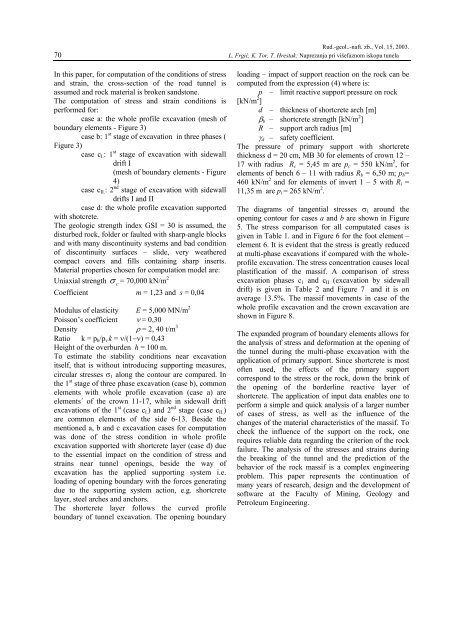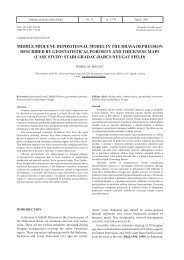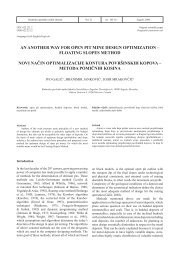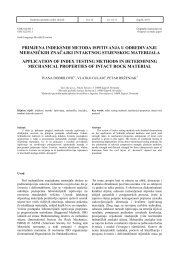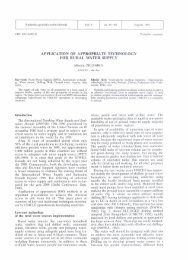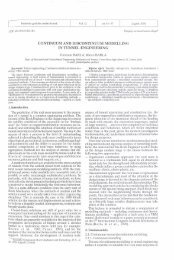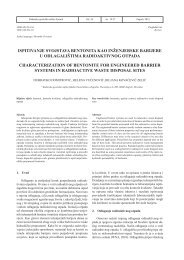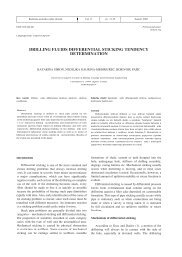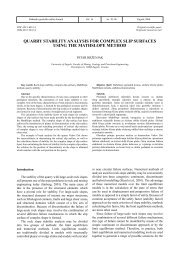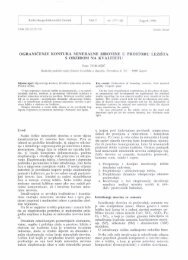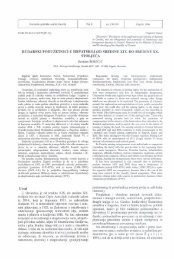pdf (637 KB)
pdf (637 KB)
pdf (637 KB)
You also want an ePaper? Increase the reach of your titles
YUMPU automatically turns print PDFs into web optimized ePapers that Google loves.
Rud.-geol..-naft. zb., Vol. 15, 2003.<br />
70 L. Frgić, K. Tor, T. Hrestak: Naprezanja pri višefaznom iskopu tunela<br />
In this paper, for computation of the conditions of stress<br />
and strain, the cross-section of the road tunnel is<br />
assumed and rock material is broken sandstone.<br />
The computation of stress and strain conditions is<br />
performed for:<br />
case a: the whole profile excavation (mesh of<br />
boundary elements - Figure 3)<br />
case b: 1 st stage of excavation in three phases (<br />
Figure 3)<br />
case c I. : 1 st stage of excavation with sidewall<br />
drift I<br />
(mesh of boundary elements - Figure<br />
4)<br />
case c II. : 2 nd stage of excavation with sidewall<br />
drifts I and II<br />
case d: the whole profile excavation supported<br />
with shotcrete.<br />
The geologic strength index GSI = 30 is assumed, the<br />
disturbed rock, folder or faulted with sharp-angle blocks<br />
and with many discontinuity systems and bad condition<br />
of discontinuity surfaces – slide, very weathered<br />
compact covers and fills containing sharp inserts.<br />
Material properties chosen for computation model are:<br />
Uniaxial strength σ = 70,000 kN/m 2<br />
c<br />
Coefficient m = 1,23 and s = 0,04<br />
Modulus of elasticity E = 5,000 MN/m 2<br />
Poisson’s coefficient ν = 0,30<br />
Density ρ = 2, 40 t/m 3<br />
Ratio k = p h /p v k = ν/(1−ν) = 0,43<br />
Height of the overburden h = 100 m.<br />
To estimate the stability conditions near excavation<br />
itself, that is without introducing supporting measures,<br />
circular stresses σ 1 along the contour are compared. In<br />
the 1 st stage of three phase excavation (case b), common<br />
elements with whole profile excavation (case a) are<br />
elements´ of the crown 11-17, while in sidewall drift<br />
excavations of the 1 st (case c I. ) and 2 nd stage (case c II. )<br />
are common elements of the side 6-13. Beside the<br />
mentioned a, b and c excavation cases for computation<br />
was done of the stress condition in whole profile<br />
excavation supported with shortcrete layer (case d) due<br />
to the essential impact on the condition of stress and<br />
strains near tunnel openings, beside the way of<br />
excavation has the applied supporting system i.e.<br />
loading of opening boundary with the forces generating<br />
due to the supporting system action, e.g. shortcrete<br />
layer, steel arches and anchors.<br />
The shortcrete layer follows the curved profile<br />
boundary of tunnel excavation. The opening boundary<br />
loading – impact of support reaction on the rock can be<br />
computed from the expression (4) where is:<br />
p – limit reactive support pressure on rock<br />
[kN/m 2 ]<br />
d – thickness of shortcrete arch [m]<br />
β b – shortcrete strength [kN/m 2 ]<br />
R – support arch radius [m]<br />
γ d – safety coefficient.<br />
The pressure of primary support with shortcrete<br />
thickness d = 20 cm, MB 30 for elements of crown 12 –<br />
17 with radius R c = 5,45 m are p c = 550 kN/m 2 , for<br />
elements of bench 6 – 11 with radius R b = 6,50 m; p b =<br />
460 kN/m 2 and for elements of invert 1 – 5 with R i =<br />
11,35 m are p i = 265 kN/m 2 .<br />
The diagrams of tangential stresses σ 1 around the<br />
opening contour for cases a and b are shown in Figure<br />
5. The stress comparison for all computated cases is<br />
given in Table 1. and in Figure 6 for the foot element –<br />
element 6. It is evident that the stress is greatly reduced<br />
at multi-phase excavations if compared with the wholeprofile<br />
excavation. The stress concentration causes local<br />
plastification of the massif. A comparison of stress<br />
excavation phases c 1 and c II (excavation by sidewall<br />
drift) is given in Table 2 and Figure 7 and it is on<br />
average 13.5%. The massif movements in case of the<br />
whole profile excavation and the crown excavation are<br />
shown in Figure 8.<br />
The expanded program of boundary elements allows for<br />
the analysis of stress and deformation at the opening of<br />
the tunnel during the multi-phase excavation with the<br />
application of primary support. Since shortcrete is most<br />
often used, the effects of the primary support<br />
correspond to the stress or the rock, down the brink of<br />
the opening of the borderline reactive layer of<br />
shortcrete. The application of input data enables one to<br />
perform a simple and quick analysis of a larger number<br />
of cases of stress, as well as the influence of the<br />
changes of the material characteristics of the massif. To<br />
check the influence of the support on the rock, one<br />
requires reliable data regarding the criterion of the rock<br />
failure. The analysis of the stresses and strains during<br />
the breaking of the tunnel and the prediction of the<br />
behavior of the rock massif is a complex engineering<br />
problem. This paper represents the continuation of<br />
many years of research, design and the development of<br />
software at the Faculty of Mining, Geology and<br />
Petroleum Engineering.


